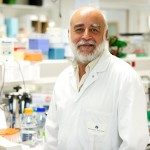Link to Pubmed [PMID] – 21501826
Link to DOI – 10.1016/j.chom.2011.03.010
Cell Host Microbe 2011 Apr; 9(4): 263-72
Shigella, the Gram-negative enteroinvasive bacterium that causes shigellosis, relies on its type III secretion system (TTSS) and injected effectors to modulate host cell functions. However, consequences of the interaction between Shigella and lymphocytes have not been investigated. We show that Shigella invades activated human CD4(+) T lymphocytes. Invasion requires a functional TTSS and results in inhibition of chemokine-induced T cell migration, an effect mediated by the TTSS effector IpgD, a phosphoinositide 4-phosphatase. Remarkably, IpgD injection into bystander T cells can occur in the absence of cell invasion. Upon IpgD-mediated hydrolysis of phosphatidylinositol 4,5-bisphosphate (PIP(2)), the pool of PIP(2) at the plasma membrane is reduced, leading to dephosphorylation of the ERM proteins and their inability to relocalize at one T cell pole upon chemokine stimulus, likely affecting the formation of the polarized edge required for cell migration. These results reveal a bacterial TTSS effector-mediated strategy to impair T cell function.



